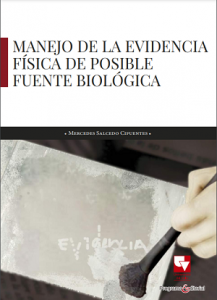Manejo de la evidencia física de posible fuente biológica
Descargas
Abacus Diagnostics, one step ABAcard hema trace for the forensic identification of human blood. Technical information sheet. 1999.
American college of emergency physicris. Evaluation and management of the sexually assalted or sexually abused patient. ww.acep.org. 1999.
Dallas Texas printed in the USA. Vía internet. Revisado 24 de junio 2003.
Art. 382, Ley 906 de 2004, Código de Procedimiento Penal.
Auvdel MJ. Comparison of laser and high-intensity quartz arc tubes in the detection of body secretions. J Forensic Sci. 1988. 33 (4) : 929-945. https://doi.org/10.1520/JFS12516J
Akin L. Blood interpretation at crime scenes. The forensic examiner. Summer 2005. online http://www.acfei.com. Revisado Marzo 4 de 2005.
Bär J. SH., Eckert WG. Interpretation of bloodstains evidence at crimescenes. 2ª Ed. Editorial CRC Press. New York, 1999.
Baechtel FS. The identification and individualization of semen stains in: safertein R, ed- Forensic Science Handbook. Engle wood cliffs. NJ: Prentice hall. 1988, 2:347-392.
Bisbing, Richard E., Finding Trace Evidence. in Mute Witnesses: Trace Evidence Analysis. Houck, Max., (ed.) Academic Press, San Diego, California. 2001.
Bevel T., Gardner R-M. Bloodstains pattern analysis. 2º Edicción. Boca Ratón Florida: Editorial CRC Press. 2002.
Blake ET., Sensabaugh GF., Bashinski J. Asystematic approach to the analysis of semen evidence. Fall semiannual seminar of the California Association of Criminalists. 1980.
Castelló A., Verdú PF. Critical revision of presumptive test for bloodstains. Forensic science communications.1999. 1(2).
Cox, M. A study of the sensitivity and specificity of four presumptive tests for blood, Journal of Forensic Sciences. 1991. 36:1503-1511. https://doi.org/10.1520/JFS13170J
Consejo Nacional de Policía Judicial. Fiscalia General de la Nación. Manual único de la policía judicial. Santafé de Bogota. 1999.
Cardini F. Técnicas de investigación criminal. Segunda edición. Editorial Dunken. Argentina. 2004.
Calvo-Calvo C., El luminol. Disponible en http://www.crimnalistica.com.mx y http://www.criminalístic.org. Revisado 8 de febrero de 2005.
Castellanos PA, Alvarez SM, Feucht M, Verdú-Pascual FA. Revelado de manchas latentes: Efectividad del luminol y evaluación de su efecto sobre el estudio de ADN. Cuad. Med.Foren. 2002; 28:33-36. https://doi.org/10.4321/S1135-76062002000200004
Dennis A. Castro B., Investigación de Delitos Sexuales. American Colleges of Forensic Examiners, U.S.A. American Board of Forensic Medicine. Toncontin, Honduras. 2001.
Exline D. L., Smith, F. P., Drexler, S. G., Frecuency of pubic hair transfer during sexual intercourse.. J Forensic Sci. 1998.43(3): 505-508. https://doi.org/10.1520/JFS16177J
Eckert, W. G., James, S. H. Interpretation of bloodstain evidence at crime scenes. New York: Editorial Elsevier. 1989.
Escrito. www.wikipedia-the free enciclopedia-blood pattern analysis at crime scenes. Revisado Julio 25 de 2005.
Escrito HTML: Serology forensic. Disponible en http://wwwfaculty.ncwc.edu/toconnor/425/425lectl3.html. Recuperado el 21 de Julio de 2005.
Espinosa A.T., Guía de pruebas andrológicas. Revista Labimed. 1994. Pag 14-21.
Franco M., Hematológica forense y otras técnicas serológicas. México. Editorial Porrúa. S.A. 2ª edicción. 1999.
Federal bureau of investigation. Trace evidence recovery guidelines. En forensic science communications. 1992. 1 (5): 700-703.
Falco F., Identificación de fluidos poco rutinarios. Química legal. Bogotá. 1989. Sin datos de editorial.
Gaensslen, R. E. Sourcebook in Forensic Serology, Immunology, and Biochemistry, U.S. Department of Justice, Washington, DC. 1983.
Gabby T., Winkleby MA., Boyce WT., Fischer DL., Lancaster A., Sensabaugh GF. Sexual abuse of children. The detection of semen on skin. A, Jo. Dis Child.
Gisberth C., J. A., Medicina Legal y Toxicología. 5º Edicción Editorial Salvat. Barcelona. 1986.
Greenshields, M., R. & Scheurman, Gordon D., The Crime Scene: Criminalistics, Science and Common Sense. Pearson Education Canada Inc.,Toronto. 2001.
Gurtovaia SV, Tuchik LN, Kurdzhieva OB. The use of the OBTI test for determining the presence and type of blood in stains. Sud Med Ekspert. 1999. 44(5):23-5.
Grunbaum, B. W., Crim M., Handbook for forensic individualization of human blood and bloodstains. Sartorius GmbH. cap 1. pag 1-7. California-US. 1981.
Grupo español y portugués de la ISFG. Recomendaciones para la recogida y envió de muestras con fines de identificación forense, Madeira-España. 2000.
Gutiérrez Y., Parasitología Forense. Revista del Instituto Nacional de Medicina Legal y Ciencias Forenses. Establecimiento Público Adscrito a la Fiscalía General de la Nación. 2002. Volumen 17. N01. Bogotá. D.C. Colombia. pag 33-38.
Hermon et al. The Use of the Hexagon OBTI Test for Detection of Human Blood at Crime Scenes and on Items of Evidence. Part I: Validation Studies and Implementation. J Forensic Sci Vol. 2003. 53.
Hochmeister MN, Budowle B, Rudin O, Gehrig, UB, Thali M, Dirnhofer R. Evaluation of prostate-specific antigen (PSA) membrane test assays for the forensic identification of seminal fluid. J Forens Sci. 1999. 44: 1057-1060. https://doi.org/10.1520/JFS12042J
Hazen C. Measurement of acid phosphatase activity to identify seminal stains. The Journal of Criminal Law Criminology and Police Science. 1955. 46 (3): 408-413. https://doi.org/10.2307/1139441
Hoscheister M. N., Rudin O., Ambach E., PCR analysis from cigarette butts, postage stamps, envelope sealing flaps, and other saliva-stained material. Cap 4. pag 24. The Forensic DNA profiling protocols. Vol 98. Human press. 1998.
Instituto Nacional de Medicina Legal y Ciencias Forenses. Guía para la recolección y manejo de vestigios biológicos susceptibles de análisis genético. Colombia. Autoedición. Diseño Gráfico. Impresión. Área de Publicaciones. 1998.
IABPA (International Association of Bloodstain Pattern Analysts). Suggested IABPA Terminology List. http://www.iabpa.org/Terminology.pdf. Revisado 15 Octubre de 2005.
Instituto Nacional de Medicina Legal y Ciencias Forenses. Reglamento técnico para el análisis integral de la víctima en la investigación del delito sexual. 2006. Versión 02. Fondo de Poblaciones de las Naciones Unidas.
Instituto Nacional de Medicina Legal y Ciencias Forenses. Manual de serología forense. Bogotá-Colombia. 1999.
James S. H., Eckert W. G. Interpretation of bloodstains evidence at crime scenes. 2ª Ed. New York: Editorial CRC Press. 1999
Joshi U. N., Subhedar S. K. Saraf D. K.. Effect of water Immersion on seminal stains on cotton cloth. Forensic Science Internacional. 1981. 17: 9 - 11. https://doi.org/10.1016/0379-0738(81)90182-1
Jiménez R. Estudio criminalístico de pelos y fibras. Instituto Nacional de Ciencias Penales México. 1º edición. 1981.
Kubic, Thomas A. & Petraco Nicholas. Microanalysis and Examination of Trace Evidence in Forensic Science: An Introduction Scientific Investigative Techniques. J.H. Stuart & J. Nordby (eds). CRC Press LLC, Boca Ratón , Florida. 2003.
Kvitko L.A. La Violación. Editorial Trillas. México. cap 4. 1991.
Locard, E. Manual de técnica policíaca. 2ª edición. Editorial José Monteso. Barcelona. 1943.
Laux DL., Cistis SS. Forensic detection of semen III. Detection of PSA using membane based test: Sensitivity issues with regards to the presence of PSA in other body fluids. Submitted MAFS Newsletter. 2003.
Lorente J.A., Lorente M., El ADN y la identificación en la investigación criminal y en la paternidad biológica. Editorial COMARES. Granada (España).1995.
López P., Gómez S. P. Investigación criminal y criminalística; Segunda edición. Editorial TEMIS S.A. España. 2003.
L.O. Barsegyantz, M.F. Veresshchaka. Medico-legal examination of human hairs . Editorial Mockba. URSS. 1982.
Lundquist F., Medico legal identification of seminal stains using acid phosphatase test. Archives of Patology,1950. 50. 113-119.
Lincoln C., McBride P., Tubett G. A protocol for the use of an alternative light source to facilitate detection of corroborate trace evidence in sexual assault investigations. 7th Indo-Pacific congress on legal medical and forensic sciences. Melbourne 16th-21st September 2001.
LLoyd, J.B.F. and Weston, N.T., A spectrometric study of the fluorescence detection of fecal urobilinoids. 1998. JFS, 27, 352-356.
Martínez M. B., La prueba del ADN en medicina forense. Editorial Masson. España. 1999.
Metro-Dade police department. Handbook of physical evidence. Editorial Board of Country Commissioners. USA.1996.
Marshall Ms S., Bennett A., Fraval H., Rofin Australia Pty Ltd. Melbourne Australia. Locating Semen on Live Skin Using Visible Fluorescence. 2001.
Maher J., Vintiner S., Elliot D., Melia L. Evalution of the Biosign PSA membrane test for the identification of semen stains in forensic casework NZ Med J.2002. 115 (1147):48-49.
Nelsón D., Santucci K., An alternative Light source to detecte semen. Academic emergency medicine. 2002. 9(10):1045-1048.
https://doi.org/10.1197/aemj.9.10.1045
Nishi K, Rand S, Nakagawa AY, Yamasaki S, Yamamoto Y, Kobayashi A, Kane M, Morimoto A, Spalthoff H, Annuss B. ABO Blood Typing from Forensic Materials - Merits and demerits of detection methods utilized in our laboratories, and biological significance of the antigens. Anil Aggrawal&rsquos; Internet Journal of Forensic Medicine and Toxicology. [serial online], 2005;6(2). http://www.geradts.com/anil/ij/vol_006_no_002/papers/paper001.html. Revisado marzo 5 de 2005.
Nishi K., Mizumoto J., Wada K., Tsuji T., Kimura A. Reliability of blood grouping on aged blood to direct hemagglutination methods and absorption elution method. Nippon Hoigaku Zasshi. 1985; 39(2): 131-137.
Owen, D. Hidden Evidence: Forty True Crimes and how Forensic science solved them. Firefly Books Inc., Buffalo, N.Y. 2000.
Penagos L.D., Proteína P-30 por contrainmunoelectroforesis en casos de delito sexual en Santiago de Cali. Tesis para optar al tirulo de Bacterióloga de la Universidad Católica de Manizales. 1997.
Poyntz FM., Martin PD. Comparison of P30 and acid phosphatase levels in post-coital vaginal swabs from donor and case-work studies. Forensic Sci Int. 1984.24: 17-25. https://doi.org/10.1016/0379-0738(84)90147-6
Paredes M. Huellas de ADN en la escena del crimen. Rev Innovación y Ciencia. Bogotá-Colombia. 8(2).1999.
Resolución 2869 de 2003. Fiscalia General de la Nación: Manual de Cadena de Custodia.
Resolución 6394 de 2004. Fiscalía General de la Nación.
Resolución 2770 de 2005. Fiscalía General de la Nación.
Robert R.J. Grispino, M.A. Serological Evidence in Sexual Assault Investigations Crime & Clues- http://crimeandclues.com. Consultado julio 25 de 2005.
Sánchez S.M., Vargas M., Identificación Criminal. Editorial Jurídica de Colombia LTD. Colombia. 1993.
Spear TF, Binkley SA. The HemeSelect test: a simple and sensitive forensic species test. J Forensic Sci Soc. 1994. 34(1):41-6.
https://doi.org/10.1016/S0015-7368(94)72881-4
Saferstein, R. Criminalistics: An Introduction to Forensic Science. (8th ed.) Pearson Education Inc., Upper Saddle River, New Jersey. 2004.
Slemko J. Bloddstain pattern analysis tutorial. Disponible en http://www.acfei.com. Revisado febrero 8 de 2005.
Sensabaug GF. Biochemical markers of individuality. In: Saferstein R. Forensic Science Handbook. New Jersey. Pientice Hall Inc, 1982.
Stoilovic M. Detection of semen and blood stains using polilight as a Light source. Forensic Science International.1991. 51: 289-296.
https://doi.org/10.1016/0379-0738(91)90194-N
Schiff, AF., Realibility of the acide phosphatase test for the identification of seminal fluid. JFS. 1998, 23, 844-853.
Seratec Diagnostica. Seratec PSA semiquant. Technical in formation sheet.
Seratec Diagnostica, Seratec PSA sequant. Semiquantitative membrane test for detection of seminal fluid. Techincal bulletin, 1-5. 2003.
Simich UP, Moreis SL., Klick RL., Rittenhouse-Diakon R. Validation of the
use of a commercially available kit for the identification of prostate specific antigen (PSA) in semen stains. J Forens Sci. 1999. 44 (6): 1229-1231. https://doi.org/10.1520/JFS14592J
Sensabaught G.F. Isolation and caracterization of semen specific protein human seminal plasma: a potential new marker for semen identyfication. Journal Forensic Science,1978. 23. https://doi.org/10.1520/JFS10659J
Simich UP, Moreis SL., Klick RL., Rittenhouse-Diakon R. Validation of the use of a commercially available kit for the identification of prostate specific antigen (PSA) in semen stains. J Forens Sci. 1999. 44 (6): 1229-1231. https://doi.org/10.1520/JFS14592J
Soukos NS, Crowley K, Bamberg MP, Gillies R, Doukas AG, Evans R, Kollias N. A rapid method to detect dried saliva stains swabbed from human skin using fluorescence spectroscopy. Forensic Sci Int.2000;114 (3): 133-8. https://doi.org/10.1016/S0379-0738(00)00292-9
Troger HD, Schuck M, Tutsch-Bauer E. Detection of saliva traces using test strips. Forensic Sci Int. 1984. 25(2):143-6.https://doi.org/10.1016/0379-0738(84)90023-9
Todd-Sanford-Davidsohn. El Laboratorio en el Diagnóstico Clínico. Tomo II. Editorial Marhal. España. Capitulo 15. Pag 282-303. 2005.
Whatman. FTAÒ protocols collect transport, archive and access nucleic acids all at room temperature 2002; http://www.cosmobio.com.ar/docs/fta%20protocols.pdf. Revisado Julio 17 de 2005.
Woster, J.W. and Laux, D. L., A rapid amylase mapping procedure. MAFS Newsletter. 1990. 19, 48-49.
Yeshion T.E. The forensic application of luminol as a presumptive blood test. Florida Department of Law Enforcement. pag 379-384. 1980.
Zapata C. Manual para la identificación de campo de rastros hemáticos. Universidad Gran mariscal de Ayacucho. Escuela de derecho, Bolívar, Venezuela. 2000.


Esta obra está bajo una licencia internacional Creative Commons Atribución-CompartirIgual 4.0.



